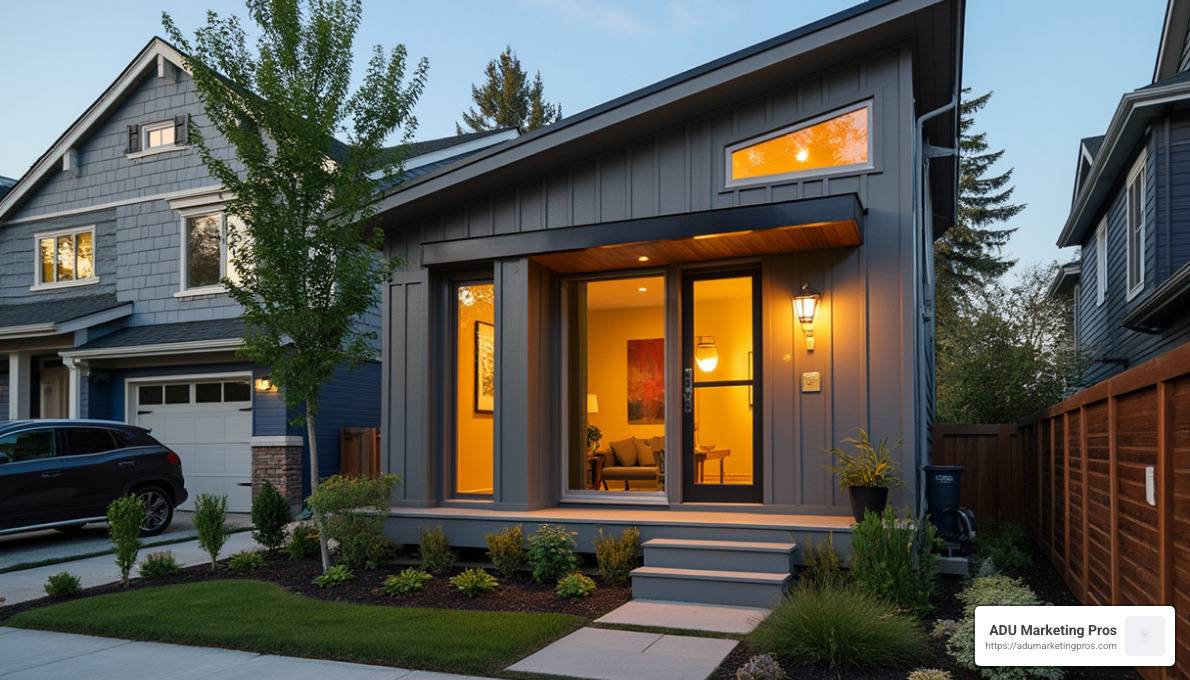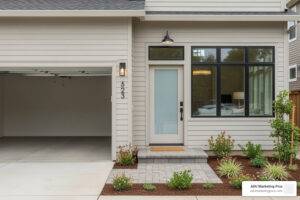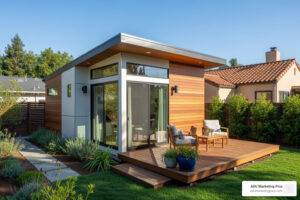ADU rental market trends are reshaping how we think about housing, especially in busy urban areas like Los Angeles. If you’re short on time, here’s a quick snapshot:
-
Addressing the Housing Shortage: Accessory Dwelling Units (ADUs) are crucial in tackling the housing crisis. These small, versatile homes maximize existing spaces, like backyards, providing new dwellings without sprawling new developments.
-
Benefits of ADUs: ADUs offer flexibility. Whether you’re looking for extra income through rentals or a space for family, these units adapt to your needs. Cities are embracing them to boost housing availability without altering neighborhood characters drastically.
-
Market Growth: The ADU market is experiencing robust expansion. With a projected 9.19% growth rate through 2032, innovations in prefabrication and modular construction are making ADUs more accessible and cost-effective.
As cities grapple with housing shortages, ADUs are emerging as valuable solutions. The combination of benefits they offer—financial, social, and environmental—is driving their popularity amidst changing residential landscapes.

Simple guide to ADU rental market trends:
ADU Rental Market Trends
When it comes to ADU rental market trends, there’s a lot to unpack, especially in vibrant areas like Los Angeles. Let’s explore some key aspects that make ADUs a compelling investment.
ROI: A Lucrative Investment
ADUs can significantly boost your return on investment (ROI). These units typically increase property values by 20-30%. In urban areas, gains can reach up to 35%. This means your property is not only generating rental income but also appreciating in value.

In terms of rental income, ADUs offer flexibility. Long-term rentals can bring in $1,940 to $2,600 monthly, while short-term rentals in prime locations might fetch up to $5,000. This range allows homeowners to choose a strategy that aligns with their financial goals.
Property Value: A Boost in Worth
ADUs are not just about rental income; they also improve overall property value. By converting underused spaces into income-generating units, property owners see a dual benefit. The added living space makes the property more attractive to buyers, who are often willing to pay a premium for homes with ADUs.
In California, for instance, ADUs can increase property values by $200,000 to $500,000 in some areas. This substantial boost is a testament to the growing demand for these versatile living spaces.
Rental Income: Consistent and Reliable
An ADU can be a reliable income source, helping to offset mortgage payments or provide a steady revenue stream. With the flexibility to choose between long-term and short-term rentals, homeowners can adapt to market conditions and personal preferences.
Long-term rentals offer stability and predictable income, making them ideal for those looking for a consistent cash flow. On the other hand, short-term rentals can yield higher returns, especially in tourist-heavy areas. However, they require more management and are subject to stricter regulations.
In conclusion, the ADU rental market trends highlight the financial benefits of investing in these units. They offer a unique opportunity to boost property value while generating consistent rental income.
Next, we’ll explore the key drivers of ADU market growth, focusing on housing affordability, urbanization, and government policies.
Key Drivers of ADU Market Growth
The ADU market is experiencing significant growth, driven by several key factors. Let’s explore how housing affordability, urbanization, and government policies are shaping this dynamic sector.
Housing Affordability: A Critical Need
Housing affordability is a pressing issue in many urban areas. ADUs offer a practical solution by providing more affordable housing options without the need for extensive new construction. They allow homeowners to house family members or generate rental income, making homeownership more accessible.
In cities like Los Angeles, where housing costs are skyrocketing, ADUs provide a viable alternative. They help alleviate the housing shortage by maximizing existing space, thus reducing the pressure on the housing market.
Urbanization: Meeting the Demand
As urbanization continues to rise, the demand for housing in city centers grows. ADUs are an effective way to increase housing density without significant infrastructure changes. They fit seamlessly into existing neighborhoods, offering additional living spaces that meet the needs of growing populations.
Urban areas like Los Angeles and San Francisco are leading the charge in ADU adoption. The compact design of ADUs makes them ideal for urban settings, where space is at a premium.
Government Policies: Encouraging Development
Government policies are playing a pivotal role in the expansion of the ADU market. Many local governments are loosening zoning regulations and providing financial incentives to encourage the development of ADUs. These measures aim to address the housing shortage and promote sustainable urban growth.
For example, some regions offer tax rebates or streamlined permitting processes to make building ADUs more appealing. These policies not only support homeowners but also stimulate local economies by creating jobs in construction and related industries.

In summary, the key drivers of ADU market growth—housing affordability, urbanization, and government policies—are propelling the market forward. These factors create a favorable environment for homeowners and investors alike, making ADUs a smart choice for those looking to capitalize on the growing demand for flexible living spaces.
Next, we’ll explore the challenges facing the ADU market, including regulatory obstacles, construction costs, and community opposition.
Challenges Facing the ADU Market
While the ADU market is booming, it’s not without its problems. Let’s explore the main challenges: regulatory obstacles, construction costs, and NIMBYism.
Regulatory Obstacles: Navigating the Red Tape
Building an ADU can be like navigating a maze of regulations. Many areas have strict zoning laws and construction requirements that make it hard for homeowners to get started. Rules about ADU size, layout, and placement can vary widely, adding layers of complexity.
In some places, these regulations are easing, but not everywhere. For homeowners in areas with tight zoning laws, getting the green light to build an ADU can be a long and frustrating process.
Construction Costs: The Price Tag Problem
The cost of building an ADU can be daunting. From utility hookups to building materials, the expenses add up quickly. Permit fees alone can be a significant barrier for many homeowners.
Financing options are also limited, making it tough to secure loans specifically for ADU projects. This financial hurdle can deter people from pursuing ADU construction, even when the long-term benefits are clear.
NIMBYism: Community Resistance
Not everyone is on board with ADUs. Some community members worry about changes in housing density or potential impacts on property values. This “Not In My Backyard” attitude can stall projects and create tension in neighborhoods.
Overcoming this resistance often requires community involvement and education. By showing the benefits of ADUs, like increased housing options and rental income, homeowners can help sway local opinion.
In conclusion, while ADU rental market trends show promise, these challenges—regulatory obstacles, construction costs, and NIMBYism—need careful navigation. Addressing these issues is key to open uping the full potential of ADUs in solving housing shortages and enhancing property value.
Next, we’ll look at the different types of ADUs and their market impact.
Types of ADUs and Their Market Impact
ADUs come in various forms, each with its own set of benefits and market implications. Let’s explore the three main types: detached ADUs, attached ADUs, and conversion ADUs.
Detached ADUs: The Standalone Option
Detached ADUs are standalone structures built separately from the main house. Think of them as mini homes on the same lot. They offer privacy and versatility, making them a popular choice in areas where space is abundant.
Market Impact: These units are highly desirable in markets like Los Angeles, where privacy is a premium. They often command higher rental prices due to their standalone nature and can significantly boost property value. Homeowners investing in detached ADUs see a high ROI, as these units are attractive for both long-term rentals and short-term stays.
Attached ADUs: The Connected Choice
Attached ADUs are connected to the main residence. They might be a basement apartment, garage conversion, or an addition to the existing structure. These units offer flexibility in design and can be more affordable to build than detached options.
Market Impact: In urban areas where land is limited, attached ADUs are in high demand. They offer a cost-effective way to increase living space without the need for additional land. The ROI is solid, especially in places where multi-generational living is common. They provide a steady rental income with a moderate initial investment.
Conversion ADUs: The Budget-Friendly Alternative
Conversion ADUs involve changing existing spaces within the home into separate living units. This could mean converting an attic, basement, or even a large room into a rental space.
Market Impact: These are the most cost-effective ADUs to build, as they use existing structures. In budget-conscious markets, conversion ADUs offer a strong ROI with minimal upfront costs. However, they may offer less privacy than detached units, which can limit rental income potential. Still, they provide a great option for homeowners looking to dip their toes into the rental market without significant investment.
Each type of ADU serves different needs and offers unique benefits. Whether you choose a detached, attached, or conversion ADU, understanding their market impact is crucial for making informed decisions about your property.
Next, we’ll explore how ADUs can be a solution to housing shortages, offering affordable and flexible living options for many.
ADUs as a Solution to Housing Shortages
Accessory Dwelling Units (ADUs) are emerging as a practical solution to the housing shortage crisis. They offer affordable and flexible living options that can address various housing needs.
Affordability
ADUs are generally more affordable to build and maintain than traditional single-family homes. Since they are often built on existing properties, there’s no need to purchase additional land, which significantly reduces costs. According to Insider Market Research, the ADU market is projected to grow from USD 10.6 billion in 2023 to USD 24.7 billion by 2031, driven by their affordability and rising demand.
For renters, ADUs provide a cost-effective alternative to high-priced apartments. This is crucial in markets where housing affordability is a major issue. With median U.S. asking rents at $1,978, many people find ADUs to be a more budget-friendly choice.
Multigenerational Living
ADUs are perfect for multigenerational living. They offer separate living spaces for family members, allowing for privacy while keeping loved ones close. This setup is increasingly popular as more families look to support aging relatives or accommodate adult children. In fact, 20% of Millennials and 68% of Gen Z-ers still live with family, highlighting the need for such arrangements.
For seniors, ADUs provide an opportunity to age in place while having family nearby for support. The 2020 Census reported that one in six Americans is over 65, and ADUs can facilitate independent yet connected living for this demographic.
Rental Alternatives
ADUs offer a viable rental alternative in a market where traditional rental units are scarce and expensive. They can help ease the demand for apartments, as renters can enjoy their own space without the high costs associated with larger units. As zoning barriers decrease, the number of ADUs is expected to rise, further contributing to the rental market.
Freddie Mac estimated in 2020 that there were 1.4 million ADUs, a number that’s likely to grow as more homeowners recognize their potential for generating rental income. This growth could lead to increased competition in the rental market, especially for entry-level units.
ADUs are proving to be a versatile solution to the housing shortage, offering affordable, flexible, and practical living arrangements for a wide range of needs. Next, we’ll dig into some of the key drivers behind the ADU market’s growth and how they are shaping the future of housing.
Frequently Asked Questions about ADU Rental Market Trends
What is the ROI on an ADU?
The return on investment (ROI) for an ADU can be quite significant. Many homeowners see a high ROI due to the additional rental income potential. Detached ADUs often offer the highest returns because they provide complete privacy and space, making them attractive to renters. In some areas, ADUs can increase property values by $200,000 to $500,000. This dual value creation—rental income and property appreciation—makes ADUs a smart investment.
Long-term rentals offer stability and predictable income, while short-term rentals can generate higher income during peak seasons. However, it’s crucial to consider local regulations, as some areas restrict short-term rentals. For instance, short-term ADU rentals are prohibited in San Diego.
How do ADUs affect property value?
ADUs can significantly boost property value. By adding living space, they increase the overall square footage and functionality of a property. In California, ADUs have been known to increase property values by hundreds of thousands of dollars. This is particularly true in urban areas like Los Angeles and San Francisco, where housing demand is high and space is limited.
Moreover, ADUs make properties more appealing to potential buyers who are interested in rental income opportunities or multigenerational living arrangements. This added flexibility can make a property stand out in a competitive market.
What are the common challenges in building ADUs?
Building an ADU comes with its own set of challenges. Regulatory obstacles are among the most common, as zoning laws and building codes can vary greatly depending on the location. Homeowners must steer permits related to zoning laws, design criteria, and building codes to avoid costly delays.
Construction costs can also be a hurdle. While ADUs are generally more affordable than building a new home, costs can add up, especially if the project involves complex designs or high-end finishes. It’s important to have a solid budget and stick to it to avoid financial pitfalls.
Lastly, NIMBYism (Not In My Backyard) can pose challenges, as some neighbors may oppose the construction of an ADU due to concerns about neighborhood character or increased density. Engaging with the community and ensuring the design blends with the existing architecture can help mitigate these concerns.
Understanding these challenges and planning accordingly can help homeowners successfully steer the process of building an ADU. In the next section, we’ll explore the key drivers of ADU market growth and how they are shaping the future landscape.
Conclusion
As we wrap up, it’s clear that the ADU rental market trends present significant opportunities for growth and investment. At ADU Marketing Pros, we specialize in helping ADU construction and architecture firms tap into these opportunities. Our approach focuses on leveraging expertise over price, ensuring that your firm stands out in a crowded market.
Market Opportunities: The ADU market is booming, driven by increasing demand for affordable housing solutions and the flexibility that ADUs offer. With projections indicating the market will reach a valuation of USD 24.7 billion by 2031, the potential for growth is substantial. Homeowners are increasingly drawn to ADUs for their ability to improve property value and generate rental income. This trend is particularly strong in urban areas where space is at a premium.
Future Outlook: Looking ahead, technological advancements in construction and design will continue to shape the ADU market. Prefabrication methods, sustainable materials, and smart home technologies are becoming standard, reducing costs and improving efficiency. Additionally, government policies supporting ADU development are likely to expand, further fueling market growth.
For ADU professionals, the key to success lies in staying informed about these trends and adapting strategies accordingly. At ADU Marketing Pros, we are committed to helping you steer this dynamic landscape with custom marketing solutions. Our focus on targeted SEO, PPC, and social media strategies ensures that your firm not only reaches potential clients but also converts them into loyal customers.
Explore how our ADU Marketing & Digital Strategies can drive measurable growth for your business. Together, we can capitalize on the opportunities within the ADU market and build a strong, recognizable brand identity.




